Our Chapel
Artwork in the Main Sanctuary
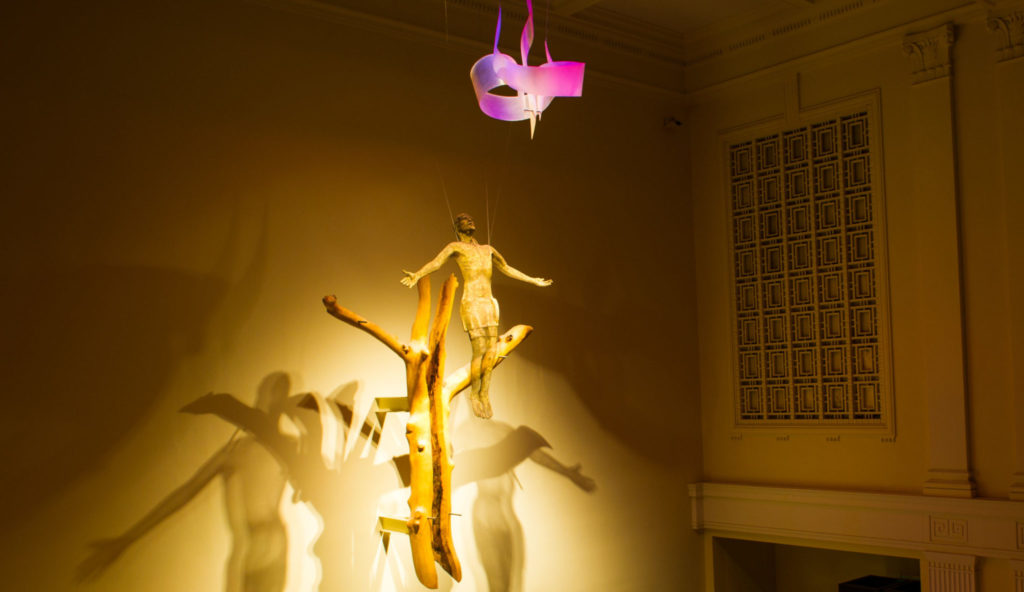 Jesus cried out in a loud voice, “Father, into your hands I commend my spirit”;
Jesus cried out in a loud voice, “Father, into your hands I commend my spirit”;
and when he had said this he breathed his last.” (Luke 23:46)
Inspired by this passage from Luke’s account of the Passion, our sanctuary artwork was installed in January 2004, the culmination of much community-wide prayer and discernment. There are three images within the piece: Cross, Crucified Christ, and Holy Spirit, crafted by two artists who met through this process. Randy Dixon, an architect and an artist from the Berkeley area, created the cross and Spirit images, and Chris Scala, an artist from Orlando, sculpted the figure of Christ. In addition, lighting is an essential element in this work.
There are three main art pieces in this work: a cross, an image of the Crucified Christ, and the Holy Spirit.
The Cross
The cross is a tree. It is mounted in the center of the back Sanctuary wall behind the Baptismal pool, and the base of the cross is located approximately 9.5 feet up from the sanctuary floor. This tree is 10 feet in height. The bark has been removed, and the artist has smoothed the surface of the trunk and dried it in a kiln. The trunk is split down the middle from top to bottom (reminiscent of the torn sanctuary curtain in the Passion narrative.) A branch protrudes from each side of the trunk. These branches represent the horizontal piece of the cross and are approximately 3.5 feet in length. These branches are not exactly symmetrical, so the image of a natural tree is evident and yet the implied cross is easily detected. There are four large metal nails embedded into the cross: one on each of the branches and two at the foot of the cross.
The Christ Figure
The corpus figure of Christ and the image of the Holy Spirit are suspended from the ceiling, over the baptismal pool. On the horizontal, the front of corpus is approximately 5 feet from the back wall. On the vertical, the top of the head of the Christ figure appears approximately 2 feet above the top of the cross. On the horizontal, the front of the Holy Spirit sculpture is approximately 8 feet from the back wall. On the vertical, the bottom of this piece appears to be approximately 3 feet above the top of the head. The image of the Holy Spirit is approximately 4.5 feet high, so the top of the piece is approximately 2 feet from the ceiling.
The corpus figure of Christ is a three-dimensional body shape and is 6 feet tall. This corpus is made of bronze and gold-plated wire mesh. The mesh is dark bronze at the feet, and the material gradually becomes more gold as you look at the torso and head. The back of the corpus is approximately 2 feet from the face of the cross; the top of the head is approximately 1.5 feet higher than the top of the cross. The face looks towards the ceiling (reminiscent of Christ looking toward the heavens). The chest is heaved upwards, indicating his last breath, and his willingness to give over his life to his Father in heaven. The five wounds of Christ are subtly present in this mesh. The face and upper body are bathed in light.
The Holy Spirit Image
The Holy Spirit is an abstract image, indicative of the Spirit symbolized as a dove, flame, and breath of God within this one sculpture. It is composed of opaque white fiberglass and is approximately 4.5 feet high and 4 feet wide. The shape is reminiscent of a swirl of satin ribbon, with the wider portion on the horizontal, with representing nonfigurative wings of a dove. The vertical piece is narrower, and the curves of this portion of the fiberglass suggest the body of the dove descending as well as flame reaching toward the ceiling. In addition, because of the curves in this portion of the sculpture, there is a sense of the breath of God or wind.
The Chapel Windows
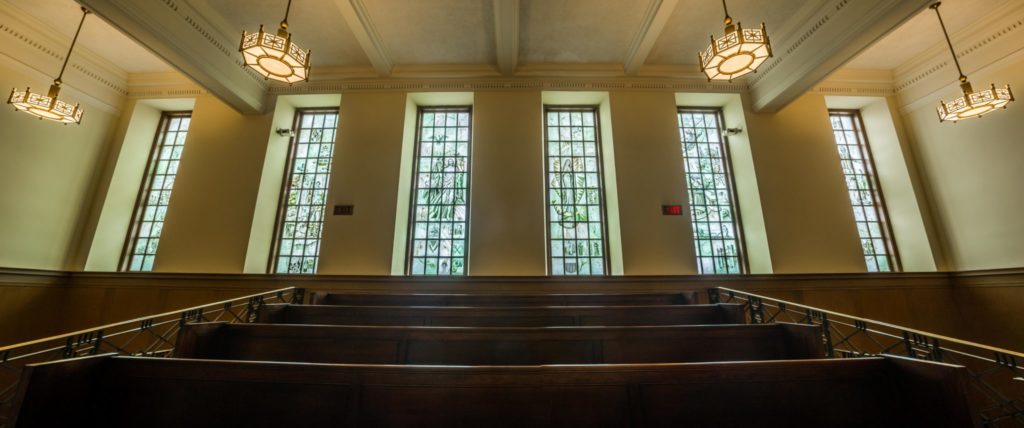 The images in these windows tell of the important events in the founding of the church in the Americas, especially efforts of early evangelization and establishment of the Paulist Fathers by Isaac Thomas Hecker. The six windows are numbered from left to right when standing inside the chapel.
The images in these windows tell of the important events in the founding of the church in the Americas, especially efforts of early evangelization and establishment of the Paulist Fathers by Isaac Thomas Hecker. The six windows are numbered from left to right when standing inside the chapel.
More about the Chapel Windows
- Window 1: The advent of Christianity is portrayed here.
- Window 2: This window represents the beginning of the Roman Catholic Church in the United States, and particularly in Maryland.
- Window 3: Shown here are Christ the Redeemer and the Seven Sacraments of the Roman Catholic Church.
- Window 4: Women feature prominently in this window.
- Window 5: The life of Servant of God, Isaac Hecker, and the founding of the Paulist Fathers are the subject of this window.
- Window 6: The beginning of the Roman Catholic Church in Boston is highlighted.
Verses from the St. Paul’s Letter to the Colossians
The verses from St. Paul’s Letter to the Colossians engraved into the front piece of the original marble altar was preserved and inserted into the edge of the balcony, near the doors of the vestibule.
LET THE WORD of CHRIST
DWELL in YOU ABUNDANTLY. (Colossian 3:16)
In addition, the words engraved on either side of the back sanctuary wall altar have been be relocated to the side balcony edges.
Lettering on Left
ABOVE ALL THINGS HAVE CHARITY
WHICH IS THE BOND OF PERFECTION. (Colossians 3:14)
Lettering on the Right
LET THE PEACE OF CHRIST REJOICE
IN YOUR HEARTS and BE YE THANKFUL. (Colossians 3:15)
The Ambry
The ambry, the repository of the holy oils, has been moved from the side of the sanctuary closer to the baptismal pool. The ambry and the tabernacle are lined with marble similar to that of the baptismal pool—emphasizing the connection of the waters of baptism with the sacred oil of the catechumens and the oil of chrism as well as the connection of the oil of the sick with the Blessed Sacrament reserved for viaticum (Eucharist for the sick and dying.) This ambry is encased in glass so we may appreciate the glory of God contained within these blessed oils.
The Four Alcoves
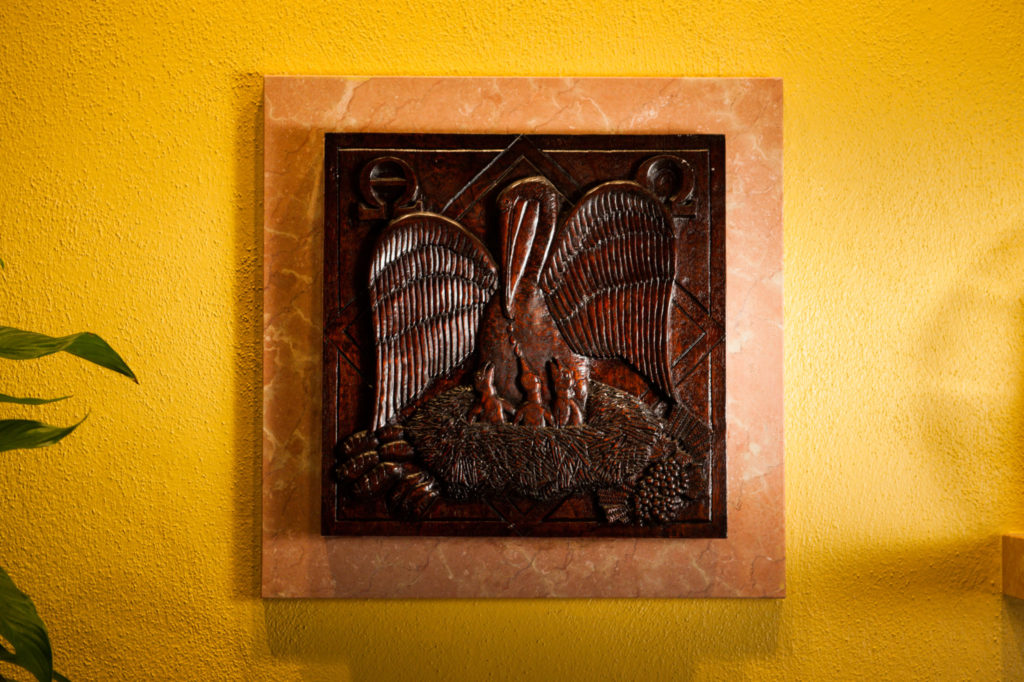
Tabernacle Alcove
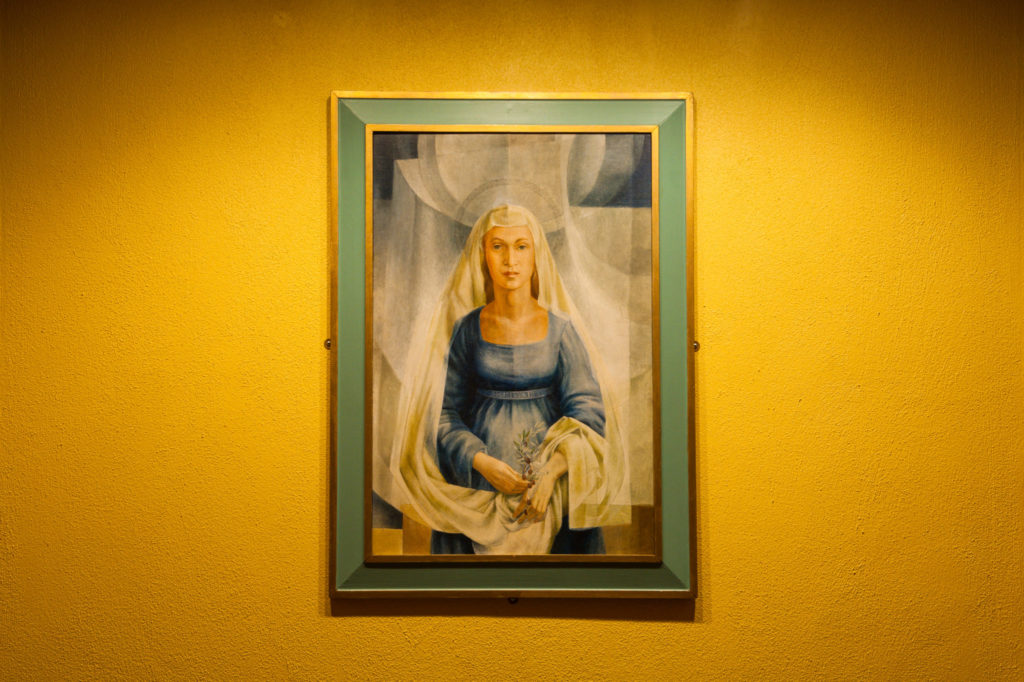
Mary Alcove
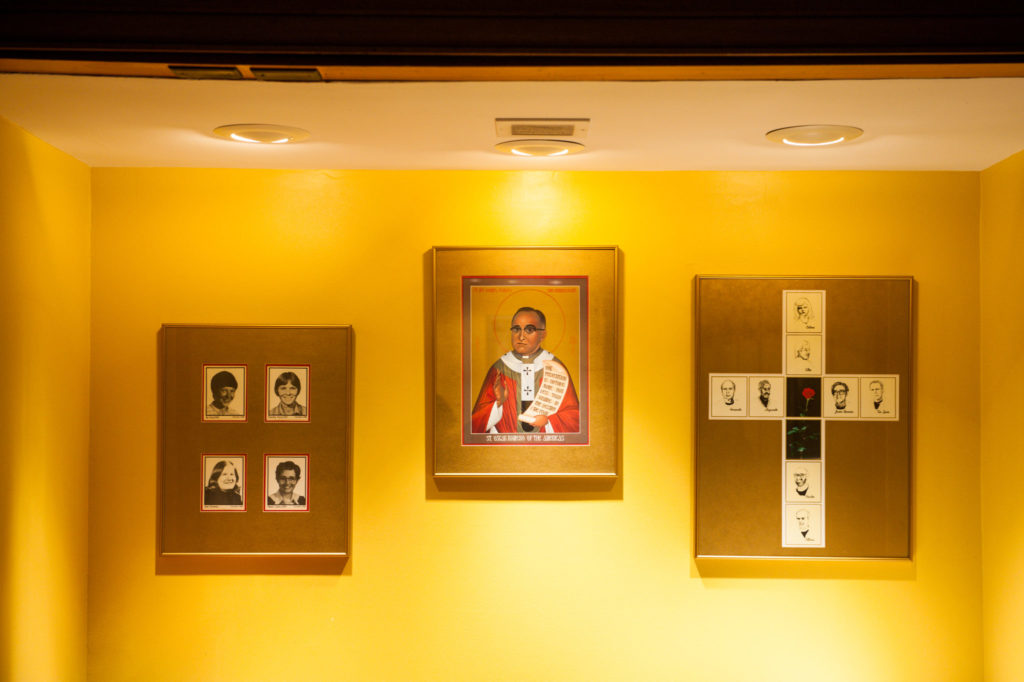
El Salvador Alcove

Hecker Alcove
You will find an alcove in each of the our corners of the chapel. The tabernacle is found in the one to the right of the altar. A portrait of Mary, the Mother of God, is located in the alcove to the left of the altar. A place to honor the martyrs of El Salvador is located in the back of the chapel, opposite the Mary alcove. The fourth alcove commemorates Servant of God, Isaac Hecker, and the recipients of the Isaac Hecker Award for Social Justice.
The Tabernacle
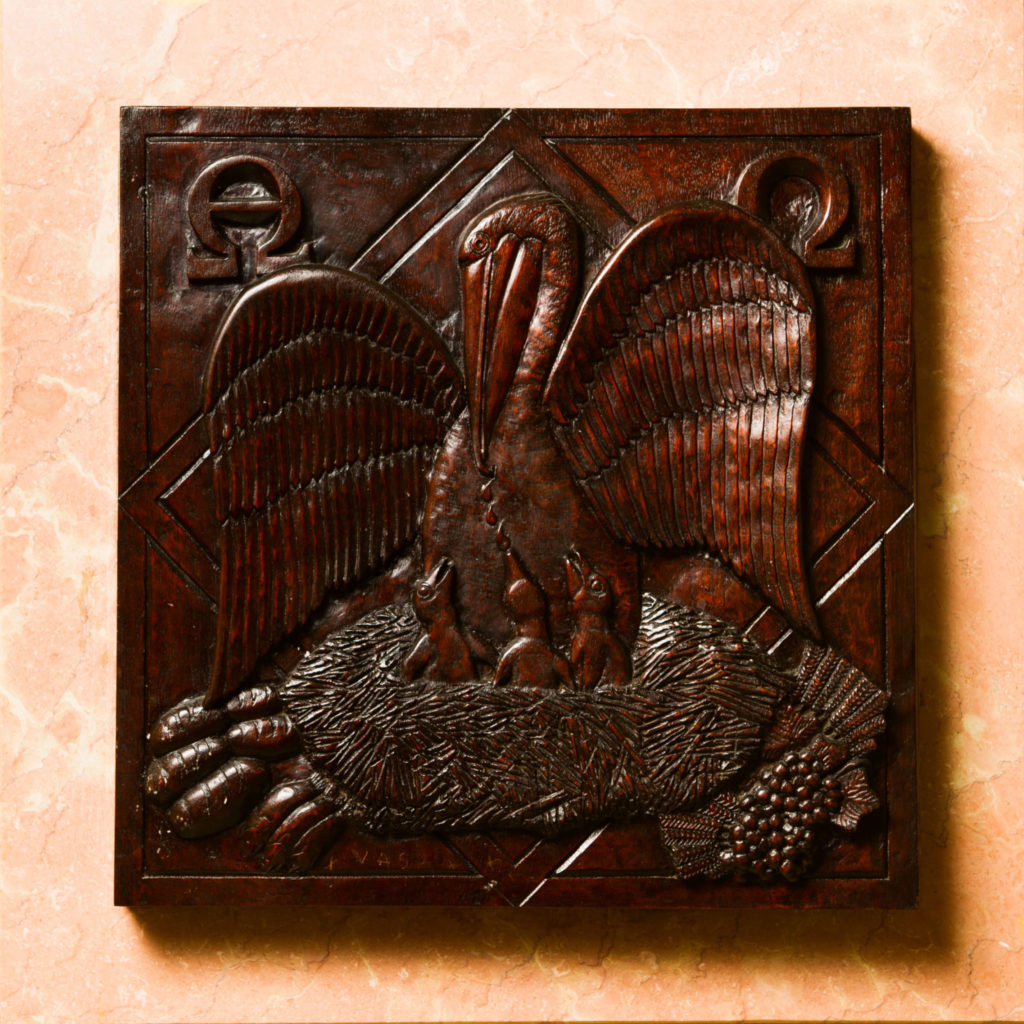 Our tabernacle has been built, recessed into the wall of the alcove in the front right corner of the chapel. The design is similar in style to that of the ambry. Like our altar, the tabernacle is made of mahogany. This symbolic link helps to remind us of the connection of our liturgical action with adoration and viaticum. We are especially pleased that Fr. Frank Sabatté, CSP, a Paulist in residence at Park Street and an artist, agreed to create and carve this beautiful addition to our chapel.
Our tabernacle has been built, recessed into the wall of the alcove in the front right corner of the chapel. The design is similar in style to that of the ambry. Like our altar, the tabernacle is made of mahogany. This symbolic link helps to remind us of the connection of our liturgical action with adoration and viaticum. We are especially pleased that Fr. Frank Sabatté, CSP, a Paulist in residence at Park Street and an artist, agreed to create and carve this beautiful addition to our chapel.
In the center of Fr. Sabatté’s design is a mother pelican surrounded by her chicks. Found in pictures in some catacombs, the pelican is one of the Church’s early symbols of Christ. A mother pelican will tear open her own chest with her beak to release life giving blood to her starving brood in times of famine and to bathe dying chicks. Because of her unselfish love, the mother pelican became a symbol of piety and perfect charity in art of many French cathedrals during the Middle Ages. There is also a mother pelican and her young cast in concrete on the front of our building.
In addition, carved into the corners of the door are other symbols of Christ and the Eucharist. Wheat and grapes remind us that the Eucharist is real food. The loaves and fish remind us that Eucharist is the food for world and that our Eucharist is intimately connected with the food we provide to the hungry at our door. The Alpha and Omega, the first and last letters of the Greek alphabet, represent Christ, “the first and the last, the beginning and the end” (Revelations 22:13), “the same yesterday and today and for ever” (Hebrews 13:8). The Alpha and Omega—symbols of Christ as the Word through Whom all creation is made and the Redeemer Who gathers all to Himself for eternity—are on the doors of the original tabernacle.
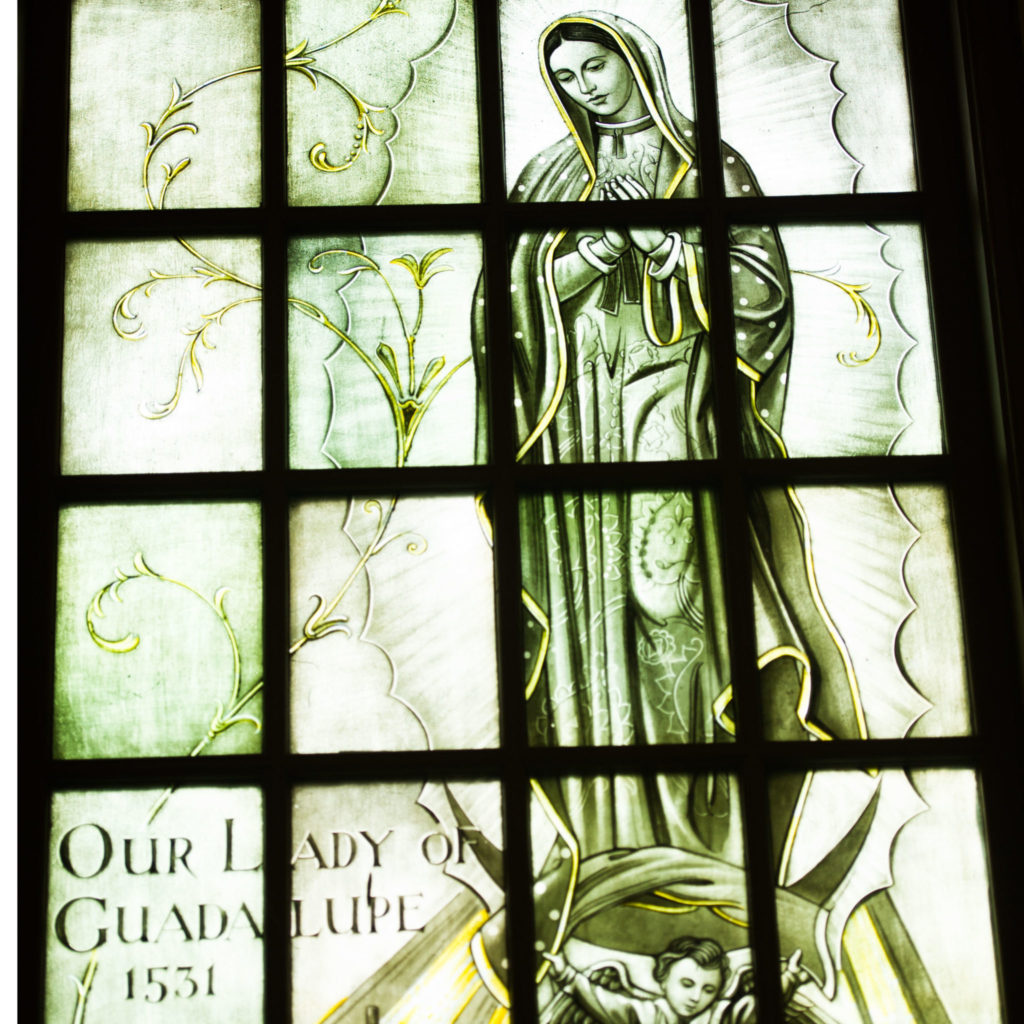 Christopher Columbus’s ships—The Niña, the Pinta, and the Santa Maria—represent the initial contact of the Native American peoples with the European Christian culture. Our Lady of Guadalupe, the first apparition of the Blessed Mother in the Americas, is also prominently featured. Our Lady of Guadalupe was declared the patroness of the Americas, and her feast day is celebrated on December 12. In addition, you will find an image of St. Junipero Serra, a Spanish Franciscan friar who founded missions in California in the mid-18th century.
Christopher Columbus’s ships—The Niña, the Pinta, and the Santa Maria—represent the initial contact of the Native American peoples with the European Christian culture. Our Lady of Guadalupe, the first apparition of the Blessed Mother in the Americas, is also prominently featured. Our Lady of Guadalupe was declared the patroness of the Americas, and her feast day is celebrated on December 12. In addition, you will find an image of St. Junipero Serra, a Spanish Franciscan friar who founded missions in California in the mid-18th century.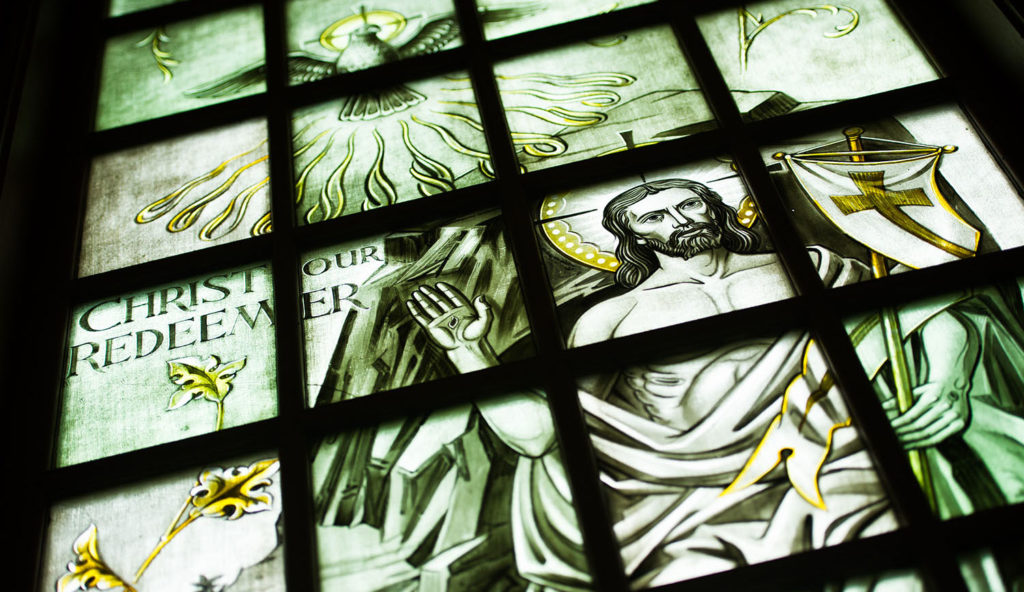 Central to the life of the Roman Catholic Church are the seven sacraments—Baptism, Confirmation, Holy Eucharist, Penance, Holy Orders, Matrimony, and Extreme Unction (as they were called when the building was dedicated in 1957.) The figure of Christ the Redeemer, the font of our sacramental life, is the prominent symbol in this window. The Holy Spirit, who remains with us and abides in the Church today, hovers at the top of this window.
Central to the life of the Roman Catholic Church are the seven sacraments—Baptism, Confirmation, Holy Eucharist, Penance, Holy Orders, Matrimony, and Extreme Unction (as they were called when the building was dedicated in 1957.) The figure of Christ the Redeemer, the font of our sacramental life, is the prominent symbol in this window. The Holy Spirit, who remains with us and abides in the Church today, hovers at the top of this window.
